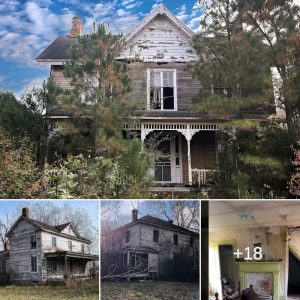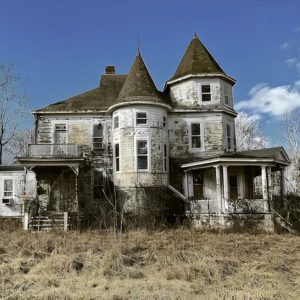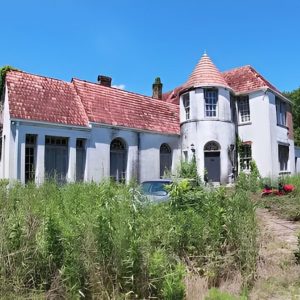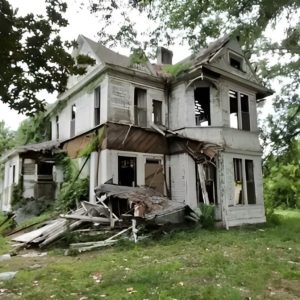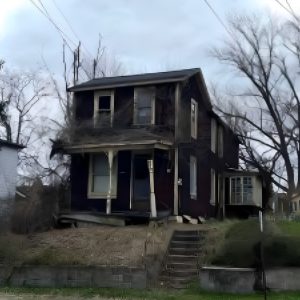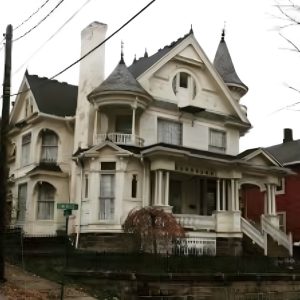This once-handsome antebellum house in the backcountry of northern Virginia was mysteriously abandoned some time ago and is the former home of a Confederate colonel.

No expense was spared on the construction of the Greek Revival-style house, which is thought to have been built between 1853 and 1856 according to local historians. Captured by Bryan Sansivero back in 2020, the two-storey property comprises 14 rooms, 12 fireplaces, an attic and an English basement, making it one of the finest and most substantial homes in the area.
An impressive 300,000 bricks were made in a kiln on the property and used to build the basement and chimneys. Sadly, the exterior is now a shadow of its former self. Virginia creeper vines cover one of the chimneys, the hitherto pristine white clapboard has turned a dull grey and the remaining shutters are rotting away.
Foreboding entrance hall
©Bryan Sansivero
The home’s entrance hall is dark and forlorn. A French Second Empire-style sofa upholstered in red velvet sits forlornly in front of several antique chairs that are stacked on top of each other.
The carpet is dirty and debris scatters the floor, but the space looks in reasonably fair condition and ripe for renovation.
Tantalising clues
©Bryan Sansivero
A side table in the entrance hall offers a tantalising glimpse of the former residents. The photographs, one of which shows the couple on a beach, look like they were taken in the 1910s or early 1920s judging by the clothes the pair are wearing.
Next to the pictures are a birthday and sympathy card, possibly dating from the 1980s, and two yellow artificial roses.
Uncared-for parlour
©Bryan Sansivero
The parlour is a vintage-lover’s dream – it’s obvious that the house had been vacant for a considerable length of time. The lath and plaster ceiling has partially collapsed, presumably as a result of water damage, and paper is peeling from the walls.
Like the entrance hall, the room contains some very attractive antique furniture including an ornate sofa and a Georgian bureau bookcase.
Dilapidated dining room
©Bryan Sansivero
The dining room appears to be in even worse shape. A 19th-century photograph depicting a person – who might have been the lady of the house way back when – hangs above the fireplace.
Sadly, nature is encroaching on the space as you can see from the overgrown vines, and the ceiling looks like it could cave in at any time. Hopefully this once handsome home doesn’t lose its fight with nature!
Time-capsule kitchen
©Bryan Sansivero
A veritable time capsule, the kitchen is packed with vintage appliances. Note the mid-century stove, kettle, coffee pots and chrome-edge countertop, not to mention the hexagonal General Electric Model 2118 pastel mosaic wall clock, which was commonplace in American homes during the 1960s.
The baby blue paint is peeling away from the kitchen’s fireplace, walls and built-in cabinets, giving an almost shabby chic effect.
Vintage wall phone
©Bryan Sansivero
The kitchen is filled with homewares that will fill you with nostalgia.
Americans of a certain age may recognise the beige wall phone. Popular in the 1960s, the ITT rotary model featured in many a kitchen.
Old-fashioned medicine cabinet
©Bryan Sansivero
The kitchen’s medicine cabinet contains a variety of pills and potions.
They include a dusty old bottle of Swan castor oil, which is still produced to this day, as well as the pain-relieving drug Ascriptin and several other curious concoctions that you may expect to find in a doctor’s house!
Broken-down basement
©Bryan Sansivero
Now let’s head downstairs to the English basement.
Constructed from thousands of bricks, the extensive space – which as you can see was used to store everything from plant pots to old buckets is incredibly dilapidated and positively crying out for a refurb.
Liking this? Click on the Follow button above for more great stories from loveEXPLORING
Random knick-knacks
©Bryan Sansivero
Like the other spaces in the house, the basement is in dire need of a clear out. Random knick-knacks are strewn around and stacks of yellowing papers and books pack the shelves.
You can just about make out a book on insects and one on horticulture, implying that the former owners were keen gardeners.
Beat-up bedroom
©Bryan Sansivero
Just like a time warp home, the upstairs’ rooms are in an equally poor state of repair yet contain some exquisite and no doubt expensive antiques.
Exactly why they were left behind is anyone’s guess. This bedroom for instance is graced with a gorgeous Victorian armoire. The space also contains an old suitcase, vintage 1960s TV and chintz bedroom chair.
Elegant Eastlake washstand
©Bryan Sansivero
A marble-topped Eastlake washstand and dresser, which may have been purchased before the house had running water, sits against the wall of this bedroom.
A ceramic plaque with the message ‘God Bless Our Home’ is fixed to the wall above. The former residents were purportedly devout Christians and prominent members of the local Baptist church.
Dapper gentleman
©Bryan Sansivero
A photograph of a dapper gentleman sits on the mantelpiece in this bedroom. The damp problem seems especially pronounced in the room if the peeling wallpaper and mould are anything to go by.
Next to the picture is an old oil lamp and you can just make out a photograph of a child to its left.
Big-game trophy
©Bryan Sansivero
Big-game hunting is a perennially popular pastime in this part of Virginia, so it comes as no surprise that a taxidermy stag head mounted on a plaque features in one of the home’s bedrooms.
While the stuffed animal looks in good condition, the room is anything but.
Confederate colonel
©Bryan Sansivero
Now let’s take a look around the master bedroom. The photograph hanging above the fireplace could very well depict the property’s most notable former resident, a Confederate colonel who was part of the 41st Militia regiment and fought in the Civil War.
In front of the fireplace sits a Victorian writing bureau.
Desolate family cemetery
©Bryan Sansivero
Out in the backyard is a concrete-covered private cemetery. While we may consider them slightly creepy these days, private graveyards were once common in US homes with generation after generation buried in the same family plot.
Neglected tombstones
©Bryan Sansivero
More than 15 members of the original family who lived at the property were interred in the cemetery.
Lamentably, the tombstones have been poorly maintained and the people who lie buried there appear to have been largely forgotten given the general state of the graveyard.
Second World War heroes
©Bryan Sansivero
One of the home’s former residents may well appear in this photograph of 19 smiling members of the 121st Engineer Combat Battalion, which hangs on the wall above an old trunk.
The much-revered battalion was one of the first American units to land in Normandy on D-Day during the Second World War.
Exquisite dressing table
©Bryan Sansivero
We can only imagine the extraordinary lives of the generations of servicemen who resided in this elegant home.
Elsewhere in the bedroom, a Victorian vanity dressing table and chair complete with a fancy curved mirror stands in the corner of the room, which features dual-aspect original sash windows that flood the room with light.
Beautiful Eastlake bed
©Bryan Sansivero
Complementing the dressing table and chair, the walnut bed is an excellent example of late Victorian Eastlake style and this handcrafted piece features delicate inlaid marquetry.
Nature has invaded the space as you can see from the ivy growing up the wall. To the right of the image is a door leading to the attic.
Attic oddities
©Bryan Sansivero
Like its basement, the home’s garret is littered with random objects that nod to the history of the house and the lives of its former residents.
What look like animal skins hang from hooks on the wall along with vintage US army duffel bags.
Ornate Victorian trunk
©Bryan Sansivero
Looking around the damp-ravaged attic space, you can’t fail to be impressed by the ornate Victorian trunk.
An antique pump organ on which a bunch of old books are piled takes pride of place in the room.
Valuable antique organ
©Bryan Sansivero
On closer inspection, the pump organ is by the Weaver Organ and Piano Company. This particular model was made in York, Pennsylvania at the turn of the 20th century and is likely to be worth a significant amount of money. Similar models sell for several thousands of dollars these days.
Liked this? Click on the Follow button above for more great stories from loveEXPLORING
























